Invitrogen™
DNA, RNA, Protein, and Cell Purification
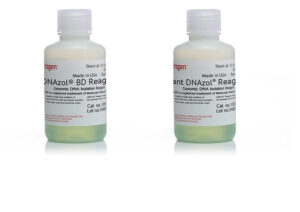 | DNAzol Reagents Efficient isolation of genomic DNA from a variety of sample types The DNAzol® Reagent procedure uses a novel guanidine-detergent lysing solution that permits selective precipitation of DNA from cell lysate. 1 mL of DNAzol® Reagent can be used to isolate genomic DNA from 1–3 x 107 cells, from 0.1 mL of whole blood, or from 25–50 mg tissue. Rapid isolation and high recovery of genomic DNA The DNAzol® Reagent combines reliability, efficiency, and simplicity in its DNA isolation protocol. During isolation, a biological sample is lysed (or homogenized) in DNAzol® Reagent, and the genomic DNA is then precipitated from the lysate with ethanol. Following an ethanol wash, DNA may be solubilized in either water or 8 mM NaOH. The entire procedure can be completed in 10–30 min with DNA recovery of 70–100%. Isolated DNA can be used for a number of downstream applications Genomic DNA extracted using the DNAzol® procedure is suitable for a variety of applications, including Southern blotting, cloning, PCR, restriction endonuclease digestion, and dot blot hybridization. |
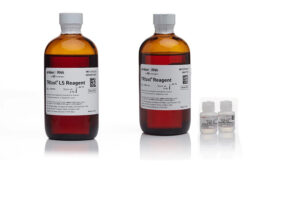 | TRIzol RNA Isolation Reagents Invitrogen TRIzol products are referenced in thousands of journal publications, reflecting the trust that molecular biologists have placed in TRIzol Reagent to deliver high-quality, intact RNA from many kinds of biological materials. TRIzol reagents are offered in several ready-to-use formats. The individual products within the TRIzol reagent family are tailored to isolate total RNA or to simultaneously isolate RNA, DNA, and protein from diverse biological sources, including samples of human, animal, plant, yeast, bacterial, and viral origin. |
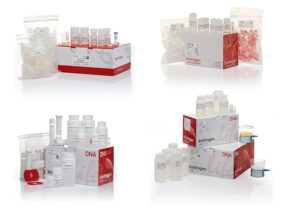 | PureLink Kits The Invitrogen PureLink nucleic acid purification kits are a family of purification products designed to meet the challenges posed by specific nucleic acid types, sample sources and volumes, throughput levels and downstream applications. These kits are based on either silica-membrane, anion exchange resin, or advanced silica-membrane purification technologies. |
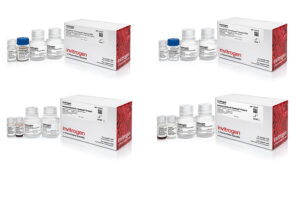 | Dynabeads Invitrogen Dynabeads magnetic separation products provide most reliable and reproducible results for purification and analysis of cells, proteins, DNA, RNA and other molecules. Dynabeads products are very gentle, as these magnetic beads capture targets of interest from the biological samples placed in tubes or plates, and no columns or centrifugation steps are required |
PCR Amplification and Reverse Transcription
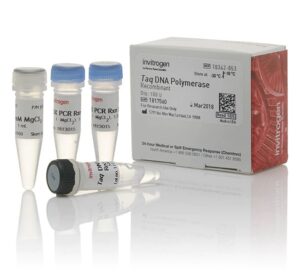 | Taq DNA Polymerase (Native and Recombinant) Isolated from the thermophilic bacterium Thermus aquaticus, Taq DNA polymerase is one of the best-known thermostable DNA polymerases used in PCR amplification of DNA targets. The native enzyme is purified from Thermus aquaticus YT1. The recombinant enzyme is a cloned version that is purified from E. coli. Therefore, the native Taq DNA polymerase is often preferred for amplification of bacterial DNA sequences homologous to E. coli sequences. Check out Invitrogen Taq DNA polymerases for standard PCR >> >> |
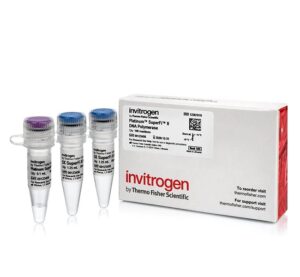 | Platinum SuperFi II DNA Polymerase For highest confidence in PCR sequence accuracy Invitrogen Platinum SuperFi II DNA Polymerase is a hot-start, engineered proofreading DNA polymerase, providing superior fidelity and specificity to your PCR. With >300x Taq fidelity and buffer specially formulated for primer annealing at 60°C, Platinum SuperFi II DNA Polymerase offers efficiency and simplicity in PCR applications requiring highest PCR accuracy, such as cloning, sequencing, and mutagenesis. Check out Invitrogen Taq DNA polymerases for standard PCR >> >> |
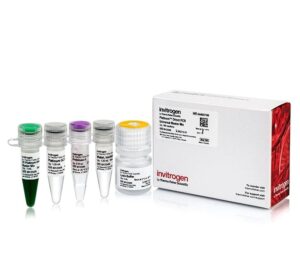 | Platinum Direct Universal PCR Master Mix Invitrogen Platinum Direct PCR Universal Master Mix is designed to amplify DNA directly from various samples without the need to purify DNA. It contains high-performing, engineered Platinum II Taq Hot-Start DNA Polymerase with dNTPs in an innovative buffer that enables universal primer annealing for superior performance in direct PCR applications. Features of Platinum Direct PCR Universal Master Mix include:
View more information about Platinum Direct PCR Universal Master Mix >> |
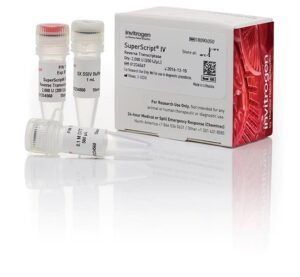 | SuperScript IV Reverse Transcriptase SuperScript® IV Reverse Transcriptase (RT) is a proprietary MMLV mutant with superior robustness and reliability in RT reactions. It is significantly improved over SuperScript® III in inhibitor resistance, processivity, and reaction speed, while retaining all the benefits of the previous enzyme, including increased thermostability, highly efficient full-length cDNA synthesis, and reduced RNase activity. SuperScript® IV RT is designed to provide reliable, consistent, and fast cDNA synthesis in the presence of inhibitors found in a wide variety of samples that cause other currently available RTs to perform inefficiently. SuperScript® IV RT is the top choice for all RT-PCR and qRT-PCR applications in the SuperScript® product family. We recommend it especially when reproducibility and reliability is the primary concern and when inhibitors in the RNA sample may interfere with cDNA synthesis, leading to biases in gene expression studies. Features of SuperScript® IV Reverse Transcriptase include:
|
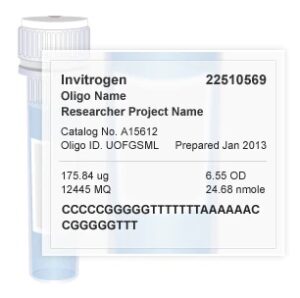 | Custom DNA Oligos Synthesis Services (Primers) Invitrogen oligos are made to your specifications, with rigorous quality control, and quick turnaround for use in a variety of applications, including PCR, cloning, sequencing, and gene detection. |
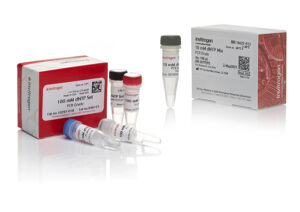 | dNTP Mix / Set Invitrogen dNTP Mix / Set consists of four nucleotides (dATP, dCTP, dGTP, dTTP) in purified water. The Invitrogen dNTP is suitable for use in polymerase chain reaction (PCR), sequencing, fill-in reactions, nick translation, cDNA synthesis, and TdT-tailing reactions. Invitrogen dNTP manufacturing meets the highest industry standards:
Features include:
Applications:
|
Nucleic Acid Quantitation
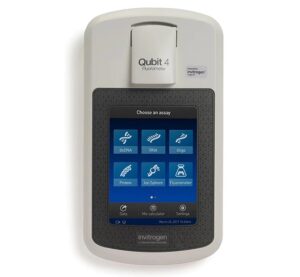 | Qubit 4.0 Fluorometer For all Qubit assays, the concentration or quality of the target molecule in the sample is reported by a fluorescent dye that emits a signal only when bound to the target, which minimizes the effects of contaminants on the result. The easy-to-use touch-screen menus make it easy to select and run the assays you need, with results displayed in just a few seconds. The Qubit 4 Fluorometer with WiFi is the latest version of the popular Qubit fluorometer designed to accurately measure DNA, RNA, and protein quantity, and now also RNA integrity and quality, using the highly sensitive Qubit assays. The Qubit 4 Fluorometer was re-engineered to enable data transfer via WiFi as well as to run the Qubit RNA IQ (integrity & quality) assay. The Qubit 4 Fluorometer and RNA IQ Assay Kit work together to accurately distinguish intact from degraded RNA in just two easy steps. |
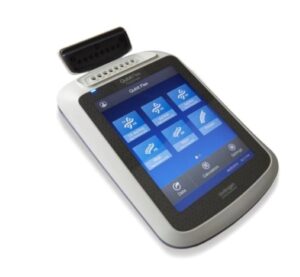 | Qubit Flex The Qubit Flex Fluorometer is a benchtop fluorometer designed for highly accurate quantification of DNA, RNA, microRNA, and protein. With the Qubit Flex Fluorometer you have the flexibility to directly measure fluorescence of up to eight samples simultaneously, which reduces assay variability. Paired with Qubit reagents, the Qubit Flex Fluorometer is part of an optimized workflow generating highly accurate and reproducible results. The fluorometer has a large screen and intuitive user interface, making it easy to select and run your desired assay with results displayed in just a few seconds. |
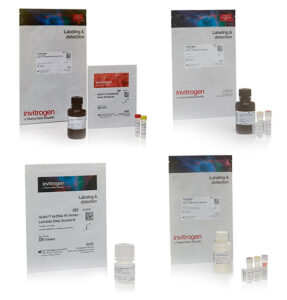 | DNA quantification assays Invitrogen™ Qubit dsDNA high-sensitivity (HS) and broad-range (BR) assays are highly selective for double-stranded DNA (dsDNA) over RNA and single-stranded DNA (ssDNA). In addition to broad range assay, we offer a high-sensitivity assay for samples with a low concentration of dsDNA, making it ideal for precious samples. Common contaminants such as salts, free nucleotides, RNA, solvents, detergents, or protein are well tolerated in the dsDNA HS and BR assays. The Qubit ssDNA Kit is ideal for quantitating single-stranded DNA or oligonucleotides. Common contaminants such as salts, free nucleotides, solvents, detergents, or protein are well tolerated in the assay. |
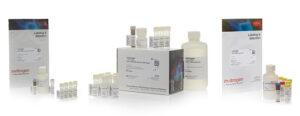 | RNA quantification assays To quantify RNA, there are three Invitrogen Qubit RNA Assay kits which include:
The assays are accurate for initial sample concentrations from as little as 250 pg/μL to 10,000 ng/μL. These kits are highly selective for RNA over double-stranded DNA (dsDNA). Unlike other RNA assays, they do not require DNase if DNA is present in the sample for an accurate measurement. Additionally, common contaminants such as salts, free nucleotides, solvents, detergents, or proteins are well tolerated in the assays. The Invitrogen Qubit microRNA Assay Kit is designed for easy and accurate quantification of small RNA (17–25 nt or bp) such as microRNA, even in the presence of common contaminants. The assay is highly selective for small RNA over rRNA or large mRNA (>1,000 bp). Small RNA have been reproducibly quantified in pure samples at levels as low as 0.5 ng in the assay tube. The assay detects all types of small RNA, including microRNA and siRNA, both single stranded and double stranded. |
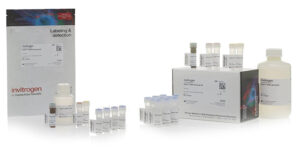 | RNA integrity and quality (IQ) assay The Qubit RNA IQ Assay utilizes two unique dyes—one that binds to large, intact and/or structured RNA, the other selectively binds to small, degraded RNA. Together they are able to quickly assess the quality and integrity of an RNA sample. To use, simply add your samples to the RNA IQ working solution, then measure on the Qubit 4 or Qubit Flex Fluorometer. Results are presented as a total value for the RNA sample integrity and quality or RNA IQ# and as the calculated % of large and small RNA in the sample . |
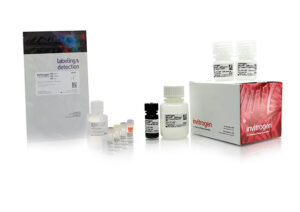 | Protein quantification assay The Invitrogen Qubit Protein Assay Kits are designed to make protein quantification easy and accurate. Two assay kits are available:
Together these assays are accurate for initial sample concentrations from 12.5 μg/mL to 20 mg/mL and exhibit low protein-to-protein variation. Common contaminants, such as reducing reagents (DTT, β-mercaptoethanol), salts, free nucleotides, amino acids, solvents, DNA, and detergents (Qubit Protein BR assay only) are well tolerated in the assays; some very slight modifications for the procedure are required for other contaminants. |
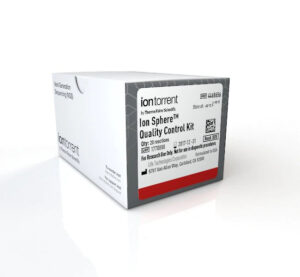 | Ion Sphere assay The Ion Sphere assay on the Qubit 4 Fluorometer enables quick and easy assessment of Ion Sphere Particles (ISPs) prior to performing a sequencing run on the Ion Personal Genome Machine (PGM) Sequencer using the Ion Sphere Quality Control Kit. All ISPs bind a complimentary, green-fluorescent Invitrogen Alexa Fluor 488 dye–labeled oligonucleotide, whereas only those beads that are template-positive bind a complementary red-fluorescent Invitrogen Alexa Fluor 647 dye–labeled oligonucleotide. The Qubit 4 Fluorometer measures the fluorescence emission of each dye conjugate, and an Excel™ file template is used to calculate the percentage of template-positive ISPs from the ratio of the Alexa Fluor 647 dye signal to the Alexa Fluor 488 dye signal. This quality-control step using the Qubit fluorometer helps determine the likelihood of a successful sequencing run, ultimately saving time and expense during subsequent sequencing. Learn more about the Ion Sphere Quality Control Kit Learn more about the next-generation sequencing on the Ion PGM System |
Agarose Gel Electrophoresis
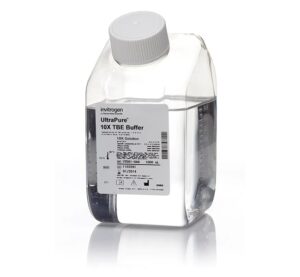 | UltraPure TBE Buffer UltraPure™ 10X TBE Buffer is a sterile-filtered solution of 1 M Tris, 0.9 M boric acid, and 0.01 M EDTA used to prepare 1X buffer for polyacrylamide and agarose gel electrophoresis. UltraPure™ 10X TBE Buffer is available in a 1 L plastic bottle or in a 10 L Cubitainer® box. Performance and quality testing: No DNase, RNase, or protease activity detected. |
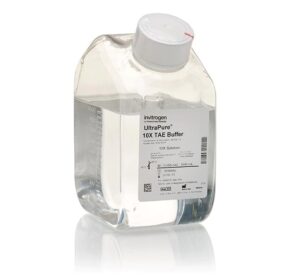 | UltraPure TAE Buffer UltraPure™ 10X TAE Buffer is a sterile-filtered solution of 400 mM Tris-acetate and 10 mM EDTA. TAE Buffer is the most commonly used buffer for agarose DNA electrophoresis. It is supplied in 1 L plastic bottles or in a 4 L or 10 L stackable Cubitainer® Box. A 1X TAE Buffer solution contains 40 mM Tris-acetate and 1 mM EDTA at pH 8.3. Performance and Quality Testing: No DNase activity detected. |
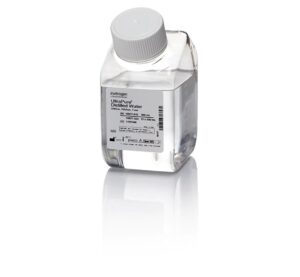 | UltraPure DNase/RNase-Free Distilled Water UltraPure™ DNase/RNase-Free Distilled Water is designed for use in all molecular biology applications. It is 0.1-µm membrane-filtered and tested for DNase and RNase activity. Performance and quality testing No DNase, RNase, or protease activity detected. Our distilled water system is routinely monitored for compliance with current USP monograph test requirements for Water for Injection (WFI). |
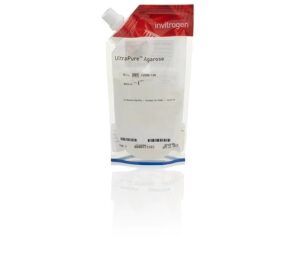 | UltraPure Agarose UltraPure™ Agarose is a polysaccharide used for size-based separation of nucleic acids in agarose gel electrophoresis applications. UltraPure™ Agarose is ideal for resolving DNA and RNA fragments from 100 bp to >30 kb. Features of UltraPure™ Agarose:
|
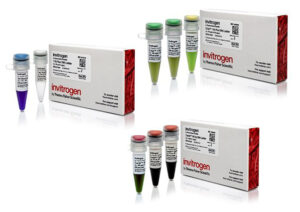 | DNA Ladders Invitrogen™ DNA Ladders are available for a wide variety of size ranges, applications, and formats. DNA Mass Ladders are specifically created for quantitative estimation of DNA mass in gels.
TrackIt DNA Ladders are ready to use and available in popular size ranges with sharp and clear bands – chromatography purified fragments for consistent and reliable results and stable at room temperature. E-Gel DNA ladders are premixed with loading buffer and formulated specifically for optimum performance on Invitrogen E-Gel precast agarose gels. |
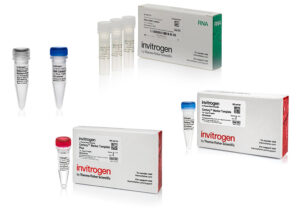 | RNA Ladders
|
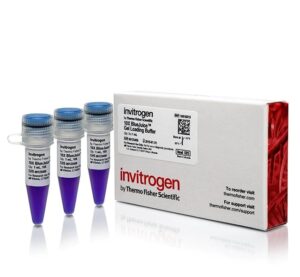 | BlueJuice Gel Loading Dye BlueJuice Gel Loading Buffer (10X) is designed for easy loading and tracking of DNA samples in agarose or native polyacrylamide gels. Visualization of DNA bands will not be obscured by the tracking dyes because they run outside the limits of most DNA samples. Product use The recommended concentration of this buffer for use with all DNA samples run on agarose gels is 1X. For acrylamide gels, the recommended concentration is 0.5 X. |
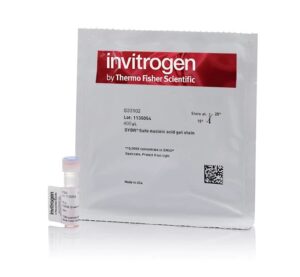 | SYBR Safe DNA Gel Stain SYBR® Safe DNA Gel Stain is a highly sensitive stain for visualization of DNA in agarose or acrylamide gels. SYBR® Safe stain is specifically formulated to be a less hazardous alternative to ethidium bromide that can utilize either blue light or UV excitation.
|
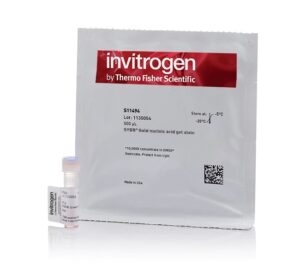 | SYBR Gold Nucleic Acid Gel Stain SYBR® Gold Nucleic Acid Gel Stain is the most sensitive fluorescent stain we offer for the detection of nucleic acids. Use with UV transilluminators, the Dark Reader (see stained nucleic acid gel below), laser scanners, or blue light transilluminators such as the Safe Imager™ 2.0 or the E-Gel® Imager. Features of SYBR® Gold Nucleic Acid Gel Stain:
|
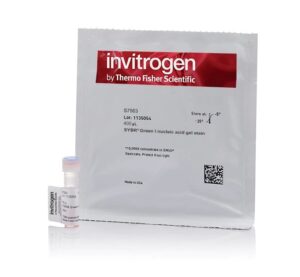 | SYBR Green Nucleic Acid Gel Stain SYBR® Green I Nucleic Acid Gel Stain is one of the most sensitive stains available for detecting double-stranded DNA (dsDNA) in agarose and polyacrylamide gels. Because SYBR® Green I has greater sensitivity for dsDNA, it is especially useful for assays where the presence of contaminating RNA or ssDNA might obscure results. With exceptionally low background fluorescence and spectral characteristics that closely match light sources and filter sets in existing instruments, SYBR® Green I stain is ideal for use with laser scanners. SYBR® Green I stain provides:
Product use One mL stains 100 minigels. Various pack sizes are available. |
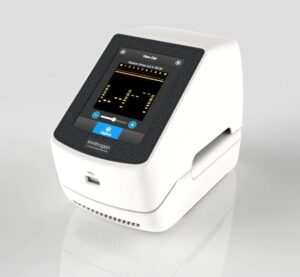 | E-Gel Power Snap Electrophoresis System The all-in-one Invitrogen E-Gel Power Snap Electrophoresis System is designed for fast and convenient E-Gel agarose gel electrophoresis, from DNA sample loading to gel image. With dry precast E-Gel agarose gel technology, you can run DNA samples in as little as 10 minutes and observe sample separation in real time. It is the only benchtop system that seamlessly integrates DNA sample separation and gel imaging into one workflow. Features of the E-Gel Power Snap Electrophoresis system include:
|
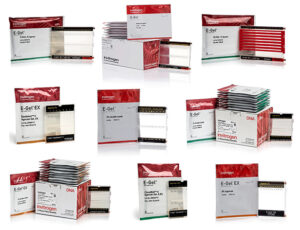 | E-Gel Precast Agarose Gels Fast and sensitive analysis of DNA and RNA samples
|
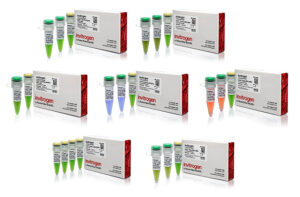 | E-Gel DNA ladders & loading buffer Invirtrogen E-Gel DNA ladders are premixed with loading buffer and formulated specifically for optimum performance on Invitrogen E-Gel precast agarose gels.
The Invitrogen E-Gel Sample Loading Buffer is a 1X buffer designed for use with E-Gel agarose gels. The buffer comes ready to use, and does not require further dilution. It contains the unique tracking dyes Xylene Cyanol FF (XCFF) and Tartrazine. These dyes allow you to visually track DNA migration during electrophoresis, and help indicate when maximum resolution is achieved. |
Protein Analysis
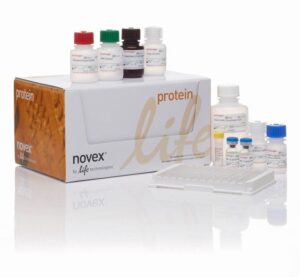 | ELISA Kits High-quality optimized Invitrogen ELISA kits allow you to measure target-specific proteins with confidence, reliability, and consistency. A variety of ELISA kit formats are available which include complete, ready-to-use kits as well as preoptimized reagents to design your own. ELISA kits and antibody pairs are available for a range of different species including human, mouse, rat, nonhuman primate, canine, porcine, bovine, equine, and feline. In addition to the off-the-shelf ELISA formats, special services such as: lot reservation, bulk packaging and custom target development are available for flexibility and convenience as you start your next research project. Check out all ELISA kits here >> |
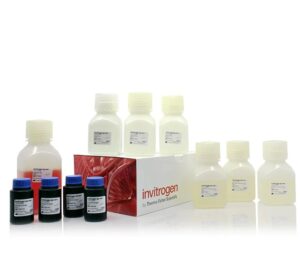 | ELISA Reagents and Buffers Select from a wide variety of easy-to-use and reliable blocking buffers and reagents for ELISA applications. ELISA buffers and reagents are important components to develop the best assay performance for high sensitivity, low background, and blocking non-specific binding. |
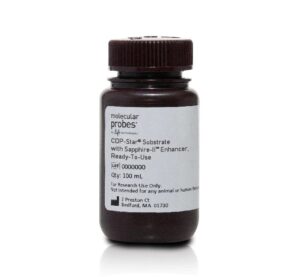 | Chemiluminescent Substrates Chemiluminescent ELISA substrates at a glance CSPD and CDP-Star are chemiluminescent 1,2-dioxetane alkaline phosphatase substrates that emit light with a maximum light intensity at a wavelength of 475 nm. These substrates are “glow” substrates and provide a sustained maximum signal over time only after 15–60 minutes depending on temperature. They are supplied at 5 or 25 mM (respectively) in aqueous buffer. Sensitivity can be improved with addition of Sapphire-II or Emerald-II luminescence enhancers. DynaLight Substrate with RapidGlow Enhancer is a ready-to-use chemiluminescent substrate formulation that has been optimized to achieve faster results in solution-based assays. This substrate is classified as a flash and glow substrate that provides fast and sustained maximum signal as early as 2–10 minutes. The DynaLight Substrate with RapidGlow Enhancer formulation includes 1,2-dioxetane chemiluminescent substrate and a polymeric enhancer that enables ultra-sensitive immunoassay detection by alkaline phosphatase label. |
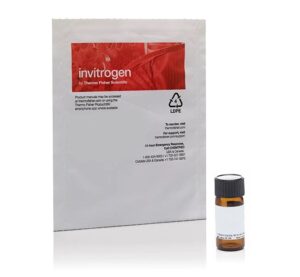 | Fluorescent substrates Fluorescent ELISA substrates at a glance Amplex Red Reagent is a highly sensitive and stable probe for H2O2. Because H2O2 is produced in many different enzymatic reactions, the Amplex Red reagent allows for detection of many different enzymes (Amplex Red Assay Kits). Amplex UltraRed Reagent improves upon the performance of Amplex Red reagent, offering brighter fluorescence and enhanced sensitivity on a per-mole basis in peroxidase or peroxidase-coupled enzyme assays. |
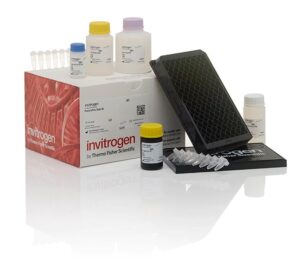 | ProcartaPlex Kits ProcartaPlex™ immunoassays are our ideal solution for assessing multiple protein biomarkers in a single sample. The ProcartaPlex assays use Luminex ™ xMAP technology for the multi-analyte detection of secreted proteins including cytokines, chemokines, growth factors and other proteins. ProcartaPlex™ assays are subject to the same stringent and robust development and manufacturing as are our extensively validated Platinum and Instant ELISA kits. Quantitate multiple targets in cell/tissue culture supernatants, serum, and plasma. Explore broad portfolio of pre-configures panels and combinable single analytes >> |
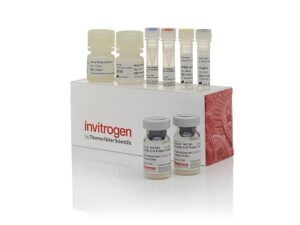 | ProQuantum Kits A powerful innovation in protein quantitation Invitrogen ProQuantum immunoassays are designed for easy-to-run, high-performance, target-specific protein detection, with no proprietary instrument to purchase. Utilizing proximity-based amplification technology, ProQuantum assays offer the analyte specificity of antibody–antigen binding with the signal detection and amplification capabilities of qPCR to achieve a highly sensitive assay. ProQuantum assays can also typically detect lower levels of protein with lower sample consumption than traditional methods. ProQuantum immunoassays benefits at-a-glance:
|
Fluorescent Protein Assays
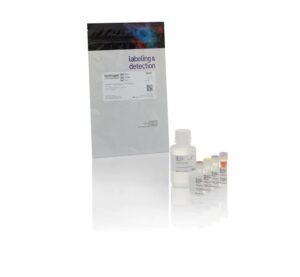 | Qubit Protein Assay The Qubit Protein Assay Kit is designed specifically for use with the Qubit Fluorometer. Using between 1 and 20 µl of your sample, this assay can quantitate samples ranging from 12.5 µg⁄ml to 5 mg⁄ml and exhibits low protein to protein variation. The assay is highly selective for proteins and is designed to be accurate in the presence of reducing reagents, but not in the presence of a large amount of detergent. Common contaminants, such as reducing reagents (DTT, β-mercaptoethanol), salts, free nucleotides, amino acids, solvents, or DNA, but not detergents, are well tolerated in the assay. Slight protocol modifications are required for other contaminants. The kit provides concentrated assay reagent, dilution buffer, and pre-diluted BSA standards. Simply dilute the reagent using the buffer provided, add your sample (any volume between 1 µL and 20 µL is acceptable), and read the concentration. |
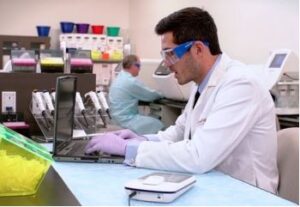 | Quant-iT Protein Assay The Quant-iT Protein Assay Kit makes protein quantitation easy and accurate. The kit provides concentrated assay reagent, dilution buffer, and pre-diluted BSA standards. Simply dilute the reagent, load it into the wells of a microplate, add 1-20 µL of sample, mix, then measure the fluorescence. The assay is highly selective for protein and exhibits very little protein-to-protein variation. The assay is performed at room temperature, and the signal is stable for 3 hours. Common contaminants, such as salts, solvents, or DNA – but not detergents – are well tolerated in the assay. Quant-iT DNA Assay Kits (Q33120, Q33130) and a Quant-iT RNA Assay Kit (Q33140) are also available. |
 | NanoOrange Protein Quantification Assay The NanoOrange Protein Quantitation Kit contains a very sensitive and easy assay for protein quantitation, with detection as low as 10 ng/mL of protein in solution. This fluorescent dye is suitable for use with spectrofluorometers and microplate readers. For detection of lipoproteins or proteins in a complex lipid environment, check out our CBQCA Protein Quantitation Kit (C-6667). |
 | CBQCA Quantification Assay The CBQCA Protein Quantitation Kit is a very sensitive assay for quantitating proteins in solution, capable of detection as low as 10 ng of protein per mL. Similar in sensitivity to our NanoOrange protein quantitation reagent (N-6666), CBQCA is better suited for accurate quantitation of proteins in the presence of lipids, membrane fractions or detergents, and for lipoproteins and small peptides. |
 | EZQ Protein Quantification Assay The EZQ™ Protein Quantitation Kit provides a fluorescence-based protein assay that facilitates fast quantitation of protein samples prepared for gel electrophoresis. The assay can be performed in the presence of detergents, urea and reducing agents – simply spot 1 µL of your protein sample onto the prepared paper, stain with our proprietary fluorescent dye, and measure the fluorescence. Samples can be quantitated by comparison with a standard curve. For added versatility, we provide a specially-designed 96-well microplate for easy quantitation of samples on a microplate reader or a laser scanner. |
Protein Electrophoresis
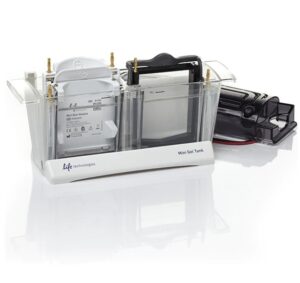 | Mini Gel Tank and Blot Module Set The Mini Gel Tank and Blot Module Set is an electrophoresis and blotting system for mini gels. The Mini Gel Tank is a vertical mini-gel electrophoresis system with a unique tank design that has convenient side-by-side gel loading and enhanced viewing during use. The tank can accommodate up to two gels per run with each gel run in its own separate chamber, making it easy to run just one gel. The tank is compatible with all Invitrogen precast mini gels and SureCast handcast gels. The Mini Blot Module is a wet transfer device used exclusively with the Mini Gel Tank. The tank accommodates one blot module per chamber, or two blot modules total with the side-by-side layout. The universal connection and molded gasket make the blot module easy to use, while the inner core of the blot module allows for use of less methanol-based transfer buffer per wet transfer. At the recommended conditions and constant voltage, proteins can be transferred to nitrocellulose or PVDF membranes typically in 30 to 60 minutes. |
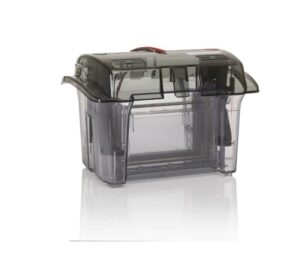 | SureLock Tandem Midi Gel Tank The Invitrogen SureLock Tandem Midi Gel Tank provides for rapid electrophoresis of midi gels using minimal buffer (~520 mL/gel) in a leak-free system. With a setup time of ~30 seconds, the tank efficiently runs midi gels while also providing consistent performance. The tank features two independent chambers, allowing electrophoresis of one or two gels at a time, which saves on buffer and limits waste. The tank is compatible with all Invitrogen pre-cast midi gels and midi gel cassettes. The SureLock Tandem Midi Gel Tank can be used for wet tank transfers when paired with the SureLock Tandem Midi Blot Module. The SureLock Tandem Midi Blot Module performs efficient, room-temperature, wet protein transfers for downstream western blot analysis. The tank accommodates two blot modules, allowing transfer of one or two gels at a time. The unique design of the SureLock Tandem Blot Module uses considerably less transfer buffer (only ~300 mL per transfer) than other wet transfer systems. This lower buffer requirement keeps the amount of methanol waste (a hazardous material) to a minimum. |
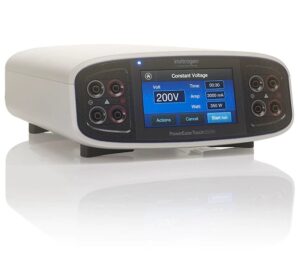 | PowerEase Touch Power Supply The Invitrogen PowerEase Touch Power Supply is a high-throughput power supply with a 4.3-inch backlit LCD touchscreen. The touchscreen and user interface design make setting up custom protocols or selecting one of the several pre-programmed gel electrophoresis and transfer methods a breeze. This power supply is ideal for high current applications like SDS-PAGE, native PAGE, western blotting, and high throughput DNA/RNA electrophoresis. The PowerEase Touch Power Supply offers four sets of output jacks that can be used simultaneously and three modes: constant voltage, constant current, and constant power for flexibility of use and efficiency. |
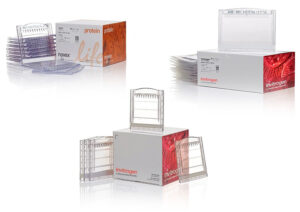 | Protein Gels Explore our protein gel options. Choose from precast polyacrylamide gel electrophoresis (PAGE) chemistries designed for specific applications, each available in a variety of well and cassette formats, or select a system for pouring and casting your own gels.
|
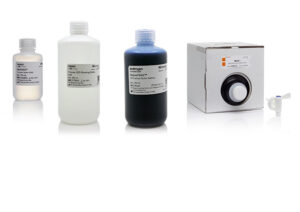 | Buffers and Reagents We offer premixed, reliable SDS-PAGE buffers and reagents including sample buffers, running buffers, reducing agents, and antioxidants.
See all available buffers and reagents available for SDS-PAGE >> |
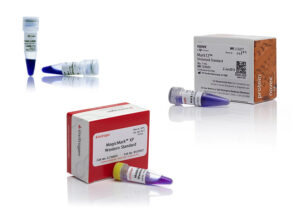 | Protein Ladders We offer complete line of Invitrogen™ protein ladders to assist you with your protein analysis:
|
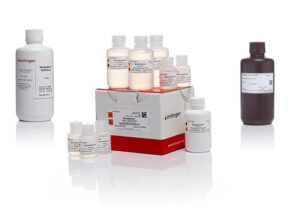 | Protein Gel Stains A wide variety of gel staining options are available for your applications, including Coomassie, silver, and fluorescent staining. Coomassie staining Invitrogen™ SimplyBlue™ SafeStain is a ready-to-use, fast, sensitive, and safe Coomassie G-250 stain for visualizing protein bands on polyacrylamide gels. SimplyBlue SafeStain is completely nonhazardous and does not require methanol or acetic acid fixatives or destains. Silver staining The Invitrogen™ SilverXpress Silver Staining Kit is a highly sensitive silver staining kit providing nanogram-level sensitivity with minimal background. The easy-to-follow protocol requires less total time than standard Coomassie staining and is complete in a little over one hour.The SilverXpress Silver Staining Kit uses ammoniacal silver chemistry and glutaraldehyde sensitization to produce a highly sensitive silver stain, capable of detecting much lower levels of protein than standard Coomassie or Colloidal Blue techniques. Clear background makes sample identification unambiguous and provides publication-quality gels. The SilverXpress kit may also be used for detecting nanogram concentrations of DNA that cannot be detected using ethidium bromide. It is five-times more sensitive than ethidium bromide, detecting as little as <0.5 ng of 50 bp DNA. Fluorescent staining Fluorescent stains are rapid, and highly sensitive for detecting total protein in protein electrophoresis gels and membranes. Fluorescent stains are designed for use in 1D and 2D PAGE and offer sensitivities similar to that obtained with silver staining techniques. Our line of SYPRO and fluorescent stains can be used for total protein quantitation and can be viewed using a standard UV or blue-light transilluminator or with imaging instruments equipped with appropriate light sources, such as iBright Imaging Systems. |
Western Blot
 | SureLock Tandem Midi Blot Module The Invitrogen SureLock Tandem Midi Blot Module is a wet transfer device used exclusively with the SureLock Tandem Midi Gel Tank. The tank accommodates one blot module per chamber, or two blot modules total. The SureLock Tandem Midi Blot Module is compatible with all Invitrogen midi gels (blot size: 8.5 cm x 14 cm). The blot module accommodates one midi gel per wet transfer. The unique design make the module easy to use, while the efficient size of the inner core uses less transfer buffer per transfer (only ~300 mL per transfer). Since transfer buffer contains methanol, this also results in less hazardous waste requiring special disposal. At the recommended conditions and constant voltage, proteins can be transferred to nitrocellulose or PVDF membranes in 30 minutes and at room temperature. |
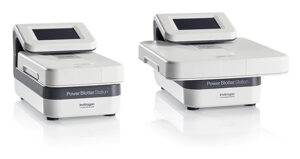 | Power Blotter Systems The Invitrogen Power Blotter System is designed specifically for rapid semi-dry transfer of proteins from polyacrylamide gels to nitrocellulose or PVDF membranes in 5 to 12 minutes. The Power Blotter features an integrated power supply optimized to enable consistent and high-efficiency protein transfer. The Invitrogen Power Blotter XL System is specifically designed for rapid semi-dry transfer of proteins from polyacrylamide gels (SDS-PAGE) to nitrocellulose or PVDF membranes in 5 to 12 minutes. The Power Blotter System includes an integrated power supply optimized to enable consistent and high-efficiency protein transfer. |
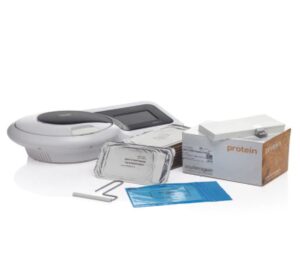 | iBlot2 Dry Blotting System The iBlot2 Dry Blotting System was designed to deliver a high degree of convenience. The iBlot2 Dry Blotting System is a true self-contained, plug-and-play system, with an integrated power supply, pre-packaged ready-to-use transfer stacks. Setup, teardown, and cleanup only takes minutes compared to the much more cumbersome and hands-on steps required for wet-tank transfer. The iBlot2 Dry Blotting System has a simple touchscreen interface and pre-programmed optimized transfer programs, with the option to customize programs to suit your needs. |
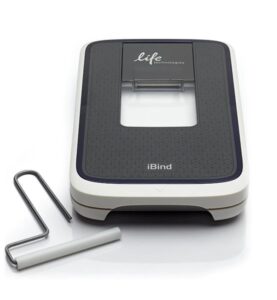 | iBind Western Device The iBind Western Device is an automated western-processing device that performs every step from blocking to washes to antibody incubations via sequential lateral flow (SLF). SLF allows the timely release and flow of solutions and antibodies to the membrane without need of an external power source, shakers, or trays. |
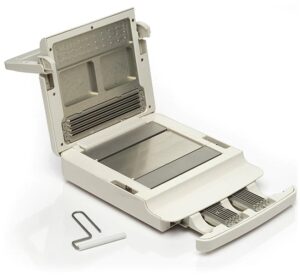 | iBind Flex Western Device The iBind Flex Western Device is an automated western-processing device that performs every step from blocking to washes to antibody incubations via sequential lateral flow (SLF). SLF allows the timely release and flow of solutions and antibodies to the membrane without need of an external power source, shakers, or trays. Each solution is released from the iBind Flex device wells to an iBind Flex Card via SLF; the solutions are then wicked towards the stack region of the card. The glass fiber matrix of the card allows for homogenous and consistent flow of the solutions to the membrane, increasing the antigen-antibody interaction. |
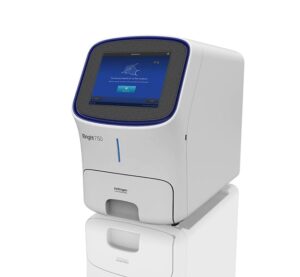 | iBright CL750 Imaging Systems Capture western blot and gel images and analyze data efficiently and easily with the Invitrogen iBright CL750 Imaging System. This system supports basic imaging applications associated with chemiluminescent western blots, as well as fluorescent stained nucleic acid gels, fluorescent stained protein gels, and colorimetric stained protein gels. |
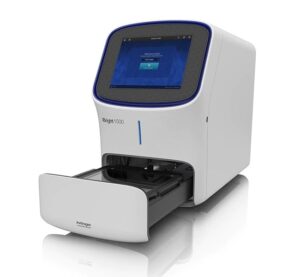 | iBright CL1500 Imaging Systems Capture images and analyze data from western blots and gels efficiently and easily with the Invitrogen iBright CL1500 Imaging System. This high-performance instrument enhances the imaging experience through powerful hardware, advanced automated technologies, and an interface that is easy to use for researchers of all experience levels. The iBright CL1500 Imaging System supports the main imaging applications of chemiluminescent and colorimetric western blots, in addition to fluorescent stained nucleic acid gels, fluorescent stained protein gels, colorimetric stained protein gels, and colorimetric membrane stains. We also offer the iBright FL1500 Imaging System, which features the same imaging capabilities as the iBright CL1500 Imaging System, but also offers fluorescent western blot imaging capability. |
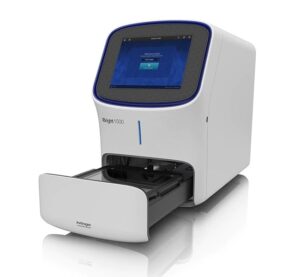 | iBright FL1500 Imaging Systems Capture images and analyze data from western blots and gels efficiently and easily with the Invitrogen iBright FL1500 Imaging System. This high-performance instrument enhances the imaging experience through powerful hardware, advanced automated technologies, and an interface that is easy to use for researchers of all experience levels. The iBright FL1500 Imaging System supports the main imaging applications of fluorescent, chemiluminescent, and colorimetric western blots, in addition to fluorescent stained nucleic acid gels, fluorescent stained protein gels, colorimetric stained protein gels, and colorimetric membrane stains. We also offer the iBright CL1500 Imaging System, which features the same imaging capabilities as the iBright FL1500 Imaging System, but without fluorescent western blot imaging functionality. |
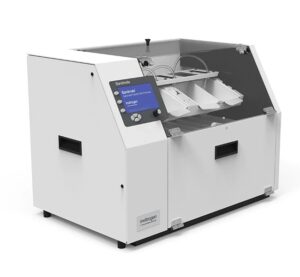 | Bandmate The Bandmate Automated Western Blot Processor is a benchtop instrument that automatically performs the hands-on steps of western blot processing, including blocking, washing, and antibody incubations. The Bandmate processor requires no special reagents and is programmable, so minimal effort is required for setup and to process your blots. |
Cell Analysis
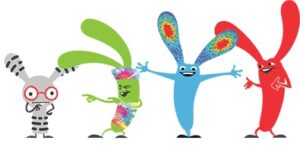 | Invitrogen Antibodies With more than 74,000 Invitrogen primary, secondary, and custom antibodies that cover 85% of the proteome, we have the antibody of your dreams – whether you do western blotting, fluorescent imaging, flow cytometry, or immunohistochemistry, we have the match you’ve been searching for. |
Automated Cell Counter
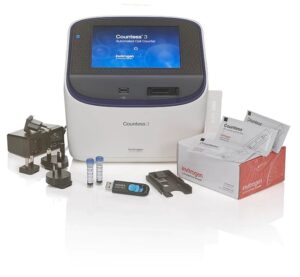 | Countess 3 The Countess 3 Automated Cell Counter is a benchtop cell counting system equipped with an advanced machine-learning algorithm, ruggedized optics, fully-automated focus and lighting, and image analysis software for rapid assessment of primary and immortalized cell samples.
The Countess 3 Automated Cell Counter works in two simple steps:
|
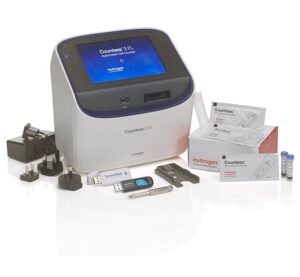 | Countess 3 FL The Countess 3 FL Automated Cell Counter is a benchtop assay platform equipped with state-of-the-art optics, fully automated focus and lighting capability, and image analysis software driven by a neural network-based machine-learning algorithm, for rapid assessment of primary and immortalized cell lines. The Countess 3 FL counter is capable of brightfield or fluorescence illumination with three-channel flexibility (brightfield and two optional fluorescence channels) enabling researchers to count cells, monitor fluorescent protein expression, gain insights to apoptotic processes, and measure cell viability.
The Countess 3 FL Automated Cell Counter works in two simple steps:
|
Flow Cytometry
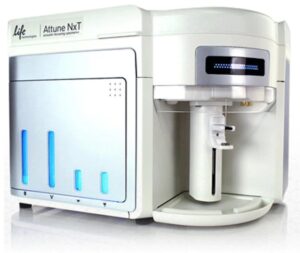 | Attune NxT The Attune NxT Flow Cytometer is a compact, benchtop cell analyzer that can be configured with up to 4 spatially separated lasers to flexibly design, run, and analyze multicolor panels of up to 14 colors. Powerful acoustic technology unique to the system, dramatically reduces workflow time in cell prep and cell processing even for troublesome large cells and dissociated tissue masses. Sample-throughput rates of up to 10 times faster than traditional systems are realized by the system without compromise to data integrity even at highest settings of 1,000 µL/min. Attune NxT software is easy to learn, teach and use. Options include a choice of autosamplers for walk-away automation and robotic integration as well as optional software for 21 CFR compliance. |
Synthetic Biology and Cloning
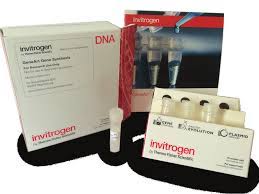 | GeneArt Synthesis High-quality custom gene synthesis GeneArt Gene Synthesis services offer ease, flexibility, and reliability for your daily DNA work. Gene synthesis is a cost-effective, time- and resource-saving method for obtaining your desired DNA construct with 100% accuracy. It is a true alternative to conventional molecular biology techniques, while enabling better, more reliable protein expression and quality. GeneArt Gene Synthesis tools go beyond traditional gene synthesis by enabling expression optimization for maximum performance. Features
|
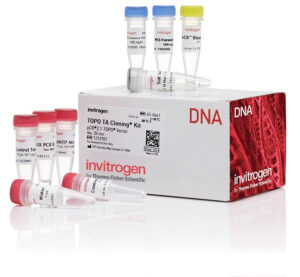 | TOPO Cloning Kits Get the cloning results you can count on TOPO cloning technology is:
Whether you’re performing general subcloning, sequencing, TA or high-fidelity blunt-end cloning, long-fragment cloning, expression-vector cloning, or directional cloning, or you’re using the Invitrogen™ Gateway™ system, there’s a TOPO cloning solution that’s right for you. TOPO PCR cloning kits help you get the right clone sooner, freeing up your time to answer more important questions. |
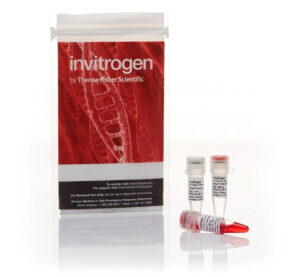 | Anza Restriction Enzymes Cloning has never been simpler The Invitrogen™ Anza™ Restriction Enzyme Cloning System is a complete system, comprised of: 128 restriction enzymes + 5 DNA modifying enzymes All Anza™ restriction enzymes work together cohesively and are fully functional with the single Anza™ buffer. The system offers:
|
Transfection
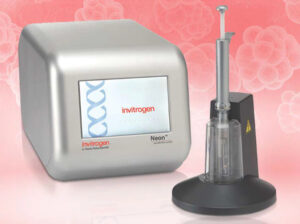 | Neon Transfection System Shockingly simple electroporation The Neon Transfection System enables superior cleavage efficiency in CRISPR gene editing applications, delivering Cas9 protein or Cas9 plasmid DNA into mammalian cell types, including primary, stem, and difficult-to-transfect cells. Unlike other electroporation instruments, this flexible and open system allows you to perform high-quality transfections using optimized or user-defined protocols in three simple steps with as few as 2 x 104 cells per reaction. A unique reaction chamber provides a dramatic increase in transfection efficiency and cell viability. The Neon Transfection System is:
|
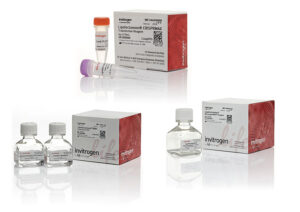 | Lipofectamine™ Reagents
|
Genome Editing
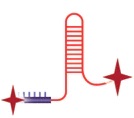 | TrueGuide Synthetic CRISPR gRNA Invitrogen™ TrueGuide™ Synthetic gRNAs are ready-to-use, synthetic gRNAs that both maximize the performance of your CRISPR-Cas9 genome editing experiments and simplify the workflow allowing you to focus on building new models and making new discoveries instead of spending time developing editing tools. TrueGuide™ Synthetic gRNAs are available as a 2-piece crRNA:tracrRNA system for standard editing tasks as well as 1-piece sgRNA and modified sgRNA formats to drive maximum editing efficiency when working with difficult-to-edit and valuable cells such as primary cells, immune cells, and stem cells.
|
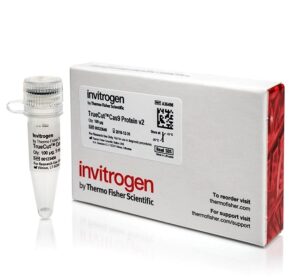 | TrueCut Cas9 v2 Invitrogen TrueCut Cas9 Protein v2 is a next-generation CRISPR Cas9 protein engineered to deliver maximum editing efficiency. Features include:
TrueCut Cas9 Protein v2 is recombinant Streptococcus pyogenes Cas9 (wt) protein, purified from E. coli, for genome editing with CRISPR technology. Cas9 protein forms a very stable ribonucleoprotein (RNP) complex with the guide RNA (gRNA) component of the CRISPR/Cas9 system. Incorporation of nuclear localization signals (NLS) aids delivery to the nucleus, increasing the rate of genomic DNA cleavage.
*For custom sizes or concentrations, please inquire. |
Gene Expression Analysis
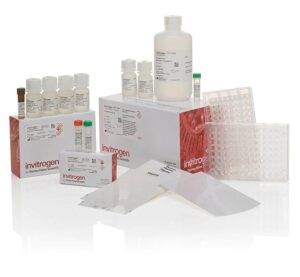 | QuantiGene™ Plex Assay Kit The QuantiGene Plex Assay Kit contains the generic reagents, buffers, and plates necessary to perform the assay in 96-well plates, and must be used with a target-specific QuantiGene Plex panel (sold separately). See related sample preparation reagents and RNA controls . The QuantiGene Plex Assay is a gene expression assay that enables multiplexed measurement of up to 80 RNA transcript targets. The assay uses target-specific probes to capture the RNA of interest, and branched DNA technology then amplifies fluorescent signals which are read with a Luminex xMAP instrument.
|
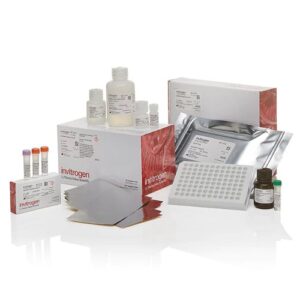 | QuantiGene™ Singleplex Assay Kit QuantiGene Singleplex assays are hybridization-based assays for the direct quantitation of RNA, DNA, or microRNA transcripts directly from cell lysates, tissue homogenates or purified RNA. They utilize branched DNA technology for signal amplification, and signal is detected using a standard luminometer. The QuantiGene Singleplex Assay Kit contains all buffers, plates, and detection reagents necessary to perform the assay in 96-well plates. Sample processing kits and target-specific probe sets are sold separately. The QuantiGene Singleplex Assay is comprised of three modules:
Features of the QuantiGene Singleplex Assay include:
QuantiGene Singleplex assays bring the power of branched DNA (bDNA) technology to basic and pre-clinical research. The bDNA assay is a sandwich nucleic acid hybridization method that uses bDNA molecules to amplify signal from captured target RNA. bDNA technology forms the basis of the FDA-approved clinical diagnostic VERSANT 3.0 assays for HIV, HCV, and HBV viral load that are offered commercially by Siemens and have been in use for over a decade. Another advantage of bDNA assays is that RNA is measured directly from the sample source, without RNA purification or enzymatic manipulation, thereby avoiding inefficiencies and variability introduced by or errors inherent to these processes. Each capture plate in this assay kit is packaged individually in a sealed foil pouch. |
Visit https://www.thermofisher.com/ to know more about the products that we offer.


